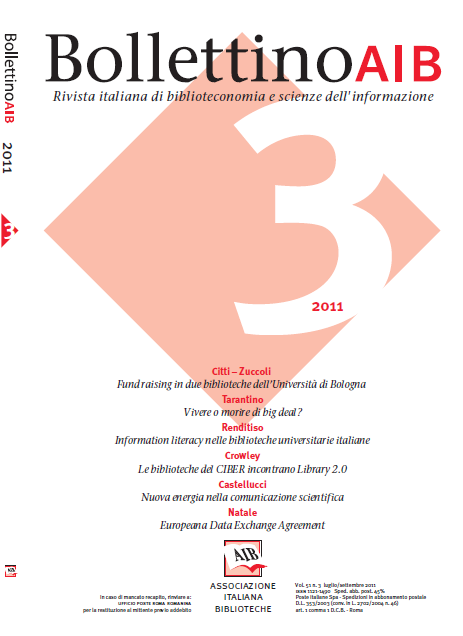Time and mass: a new energy for scholarly communication
Main Article Content
Abstract
In the electronic age, thanks to the coming of new kinds of publications - not just online or open access, but also granular and reusable, or aggregated and enhanced - the very idea of document cannot be taken for granted. The Open Access movement contributed to the redefinition of terms and functions and focused its interest on data rather than document. No doubt this is the result of the usual practice of the Open Access community to cut in scholars from both the humanities and the scientific area: the creative joint effort ofthose two cultures highlighted the importance of data among the universe of documents. Besides, data fit more easily to the Open Access principles since they can be reused and disseminated and can be extracted not only from traditional - i.e. textual, oral or visual - documents, but also from nanopublications as annotations, posts or tweets. These new systems of communication came into use, thus becoming valuable information that has to be processed, extracted and preserved just as traditional documents.
"CERN Workshop on Innovation in Scholarly Communication. OAI7" (Genève, June 22-24 2011) offered an interesting opportunity of reflection on this subject. This paper focuses especially to the sessions and tutorials coordinated by Hernest Van de Sompel, whose current research projects Memento and Open Annotation attribute a peculiar role to the notion of time and mass, thus implying a radical re-consideration not only of the idea of document, but also of those of author and reader-annotator: a new energy is entering the scholarly communication, and new actors are coming on stage.
"CERN Workshop on Innovation in Scholarly Communication. OAI7" (Genève, June 22-24 2011) offered an interesting opportunity of reflection on this subject. This paper focuses especially to the sessions and tutorials coordinated by Hernest Van de Sompel, whose current research projects Memento and Open Annotation attribute a peculiar role to the notion of time and mass, thus implying a radical re-consideration not only of the idea of document, but also of those of author and reader-annotator: a new energy is entering the scholarly communication, and new actors are coming on stage.
Article Details
Section
Note e discussioni

This work is licensed under a Creative Commons Attribution-ShareAlike 4.0 International License.
